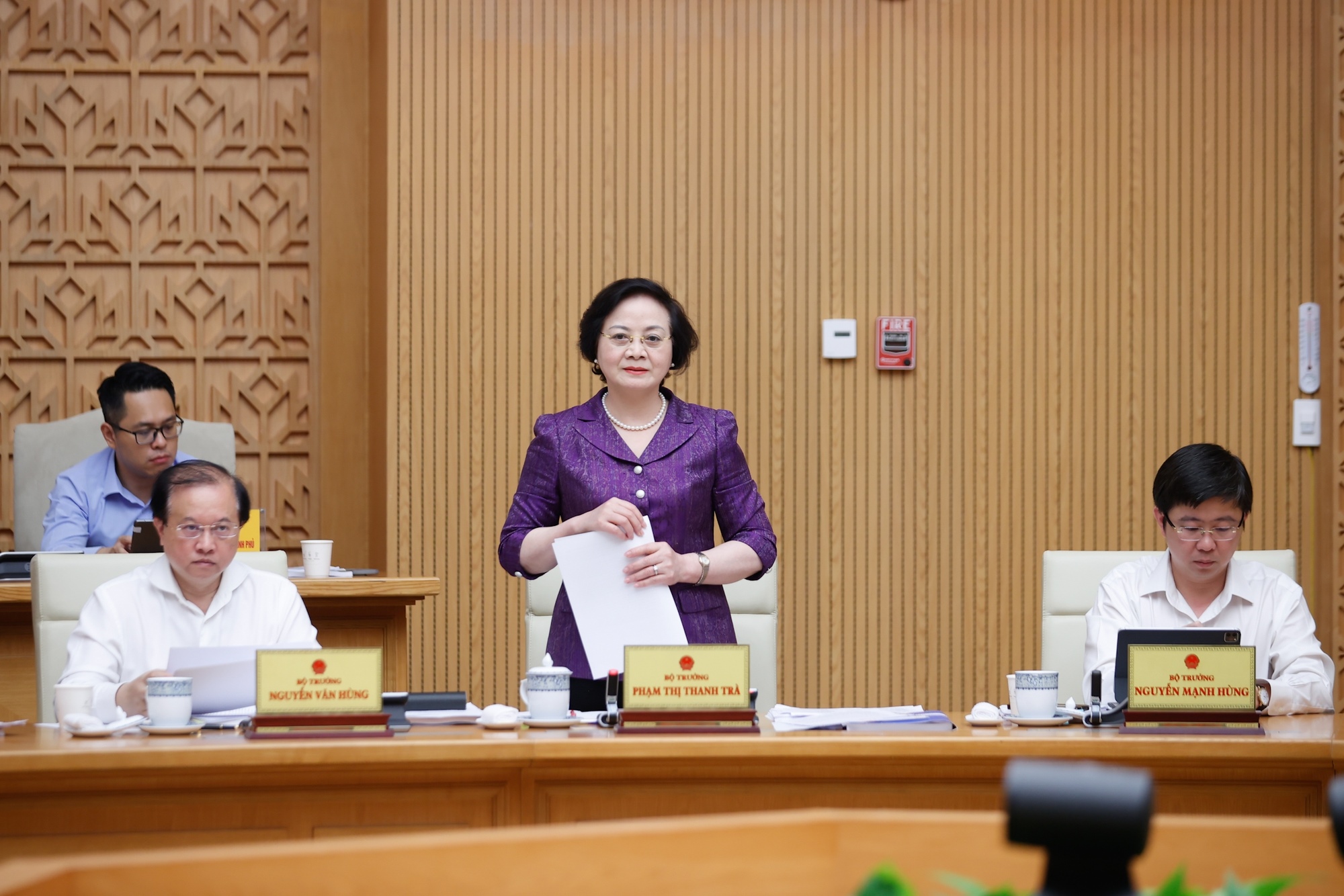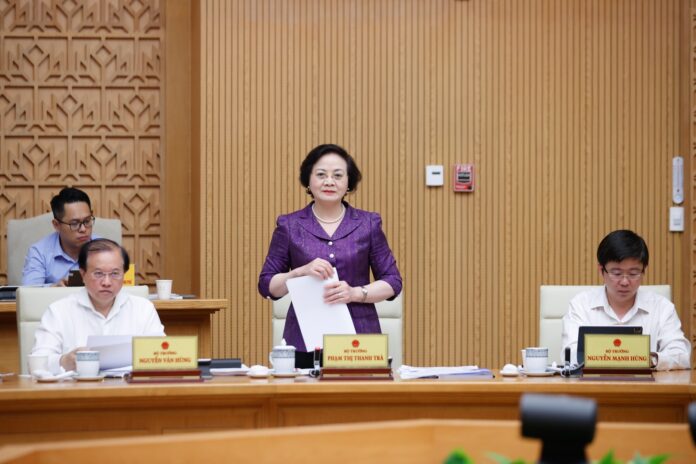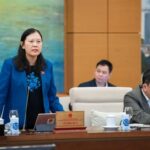
|
At the Government meeting on arranging and reorganizing administrative units (AUs) and building a two-level local government model, Minister of Home Affairs Pham Thi Thanh Tra said that localities have established Steering Committees and issued plans to implement the rearrangement of provincial and communal AUs immediately after the Politburo’s conference. She emphasized: “With the spirit of ‘running while queuing’, the entire political system has urgently joined hands”.
As of May 8, the Ministry of Home Affairs had completed all the dossiers and proposals to advise the Government to submit to the Standing Committee of the National Assembly for consideration of the rearrangement of AUs in 63 provinces and cities (belonging to 34 new provinces and cities), while also submitting the proposal for the rearrangement of provincial-level AUs to the National Assembly.
On the morning of May 9, the Government assigned the Ministry of Home Affairs to represent the Government and be authorized by the Prime Minister to sign and submit the proposal for the rearrangement of provincial and communal AUs to the National Assembly and the Standing Committee of the National Assembly in accordance with regulations.
The dossiers on the rearrangement of provincial-level AUs will be submitted to the 15th National Assembly for approval at its 9th session in May 2025. The Standing Committee of the National Assembly will also issue a synchronized 34 resolutions on the rearrangement of communal-level AUs, completing this task by June 2025 to ensure uniformity.
The Government and the Ministry of Home Affairs commit to closely monitor the process of completing the dossiers, promptly grasp difficulties and problems, and make appropriate adjustments without affecting the overall progress.
Notably, the Ministry of Home Affairs proposed that the Prime Minister present certificates of merit to 10 leading localities in building dossiers and proposals, including: Thai Nguyen, Bac Kan, Lai Chau, Lang Son, Quang Tri, Long An, Tra Vinh, Hau Giang, Soc Trang, and Can Tho.
Regarding personnel arrangement, Minister Pham Thi Thanh Tra said that the Steering Committee has provided clear guidance on the principles. For the provincial level, the total number of cadres, civil servants, and public employees after the rearrangement must not exceed the current number. Staff streamlining will be associated with restructuring and improving personnel quality, ensuring that within the next five years, the arrangement will basically comply with regulations.
When the new provincial-level government comes into operation, the Ministry of Home Affairs will coordinate with the Central Organization Commission and relevant agencies to determine suitable job positions and submit them to the competent authorities for approval of the personnel arrangement.
For the communal level, the current number of personnel at the district and communal levels will be temporarily maintained for the new units, except for those who do not meet the standards. Once the political agencies at the communal level are stable, it is tentatively planned to arrange an average of 60 personnel/commune, ward, and special district, including the Party, the Fatherland Front, and local government.
The Ministry of Home Affairs requested that central ministries and sectors closely coordinate with the National Assembly to submit laws according to the program of the 9th session; urgently complete the Decree on the authority, tasks, administrative procedures, and decentralization for the local government at the provincial and communal levels before June 10, 2025; and issue guiding documents no later than June 20, 2025.
The Ministry of Finance is assigned to report to the Government and the Prime Minister on the financial support plan for localities to implement the rearrangement according to Resolution 76/2025/UBTVQH15, ensuring that the new administrative units will soon stabilize and operate effectively.
Minister Pham Thi Thanh Tra emphasized the requirement for transparency in building personnel arrangements. She requested that the local governments of provinces and centrally-run cities proactively prepare the necessary conditions in terms of infrastructure, headquarters, finance, public assets, and personnel arrangement plans as soon as the resolutions of the National Assembly and the Standing Committee of the National Assembly are issued.
Localities need to be flexible and creative in implementing the rearrangement to suit their specific characteristics. At the same time, they should promote propaganda to help cadres, party members, and people understand the goals and significance of the rearrangement, thereby creating consensus during the implementation process.
Ms. Tra also requested that localities focus on arranging the organizational apparatus and personnel after the rearrangement, building plans to strengthen the Party, government, Fatherland Front, and socio-political organizations. The appointment and supplementation of key leadership positions must be done promptly.
Along with that, the policies for affected officials, civil servants, and public employees must be thoroughly resolved in a transparent and public manner to ensure psychological stability and organizational solidarity. During the transition period, the operation of the government apparatus at all levels must be maintained stably, without interrupting the provision of administrative procedures and public services to the people and businesses.
|
According to the Ministry of Home Affairs’ Report dated May 8, 2025, on the rearrangement of provincial and communal AUs in 2025, after the rearrangement, the country will have 34 provincial-level AUs, including 6 centrally-run cities (Hanoi, Haiphong, Hue, Danang, Can Tho, and Ho Chi Minh City) and 28 provinces (including: Lai Chau, Dien Bien, Son La, Lang Son, Cao Bang, Tuyen Quang, Lao Cai, Thai Nguyen, Phu Tho, Bac Ninh, Hung Yen, Ninh Binh, Quang Ninh, Thanh Hoa, Nghe An, Ha Tinh, Quang Tri, Quang Ngai, Gia Lai, Khanh Hoa, Lam Dong, Daklak, Dong Nai, Tay Ninh, Vinh Long, Dong Thap, Ca Mau, and An Giang). After the rearrangement of communal-level AUs in 2025, the country will have a total of 3,321 communal-level AUs (2,636 communes, 672 wards, and 13 special districts), including 3,193 newly formed communal-level AUs due to rearrangement, merging, and adjustment of communal-level AUs, and 128 communal-level AUs that are not subject to rearrangement (remain unchanged). This results in a reduction of 6,714 communal-level AUs (from 10,035 to 3,321) compared to before the rearrangement of communal-level AUs (a decrease of 66.91%). |
– 20:46 09/05/2025
The Parliamentary Committee for Local Government Reorganization: A Mid-April Reshaping of Vietnam’s Administrative Districts
In mid-April, the National Assembly’s Standing Committee will convene for an intensive session to address administrative boundary adjustments at the communal level. The session aims to reorganize approximately 60-70% of the remaining communes, setting a transformative agenda for efficient governance and improved administrative services.





















